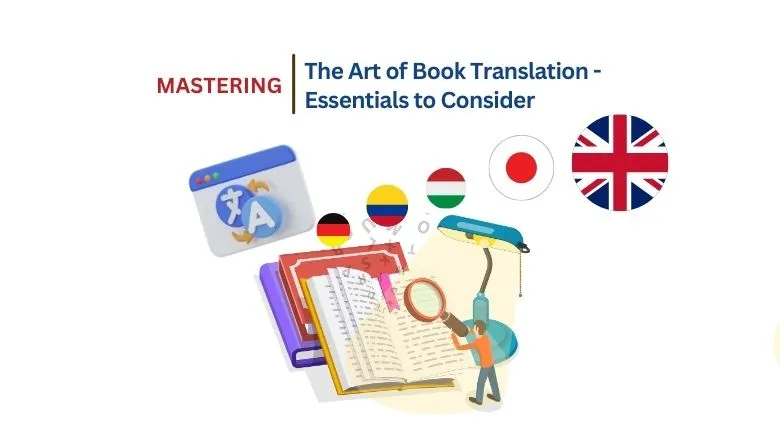 In February 2024, an Indian translator won the 7th edition of the Romain Rolland Book Prize for translating the book named “Stalin’s Couch” into Indian languages.
In February 2024, an Indian translator won the 7th edition of the Romain Rolland Book Prize for translating the book named “Stalin’s Couch” into Indian languages.
Translating a Book: Capturing the Essence
Translating a book is about capturing the original work’s essence and conveying it accurately and beautifully in the target language.
Therefore, several factors must be considered to ensure the book translation services remain true to the author’s intent and resonate with the target audience.
1. Understanding the Original Text: The Foundation of Fidelity
The first and foremost step in book translation is a proper understanding of the original text. A translator must immerse in the book, grasping its themes, tones, and nuances.
For instance, when translating Gabriel García Márquez’s One Hundred Years of Solitude, it’s essential to comprehend the rich cultural and historical context of Latin America.
2. Cultural Context: Fulfilling the Gap
Every book is a product of its cultural environment. Translators must explore the cultural differences between the source and target languages. For example, when Haruki Murakami’s novels are translated from Japanese to English, cultural elements such as Japanese idioms, traditions, and societal norms need careful adaptation. This ensures that the translated text feels natural to English-speaking readers while retaining the original’s cultural integrity.
3. Idiomatic Expressions: The Quintessence of Language
Idiomatic expressions pose significant challenges in translation. They are unique to each language and culture, making direct translations nearly impossible. Consider the French expression “avoir le cafard,” meaning “having the cockroach.”
The idiomatic meaning, however, is “feeling blue” or “being depressed.” Translators must find equivalent expressions in the target language that convey the same sentiment.
4. Author’s Voice: Echoing the Original
Maintaining the author’s unique voice is essential in book translation. Each author has a distinct style, which must be reflected in the translated work. The translator must capture her imaginative style when translating J.K. Rowling’s Harry Potter series. This requires a keen sense of the author’s writing patterns, tone, and rhythm, ensuring that readers of the translated work experience the same magic as those reading the original.
Transform Your Book into a Global Bestseller
Contact Somya Translators now to take your story to new heights!
5. Technical Terminology: Precision in Translation
In genres like science fiction or medical literature, precise translation of technical terms is important. Misinterpreting or inaccurately translating these terms can lead to significant misunderstandings.
For example, in translating Isaac Asimov’s Foundation series, it’s imperative to correctly translate scientific terms and futuristic concepts to maintain the story’s credibility and coherence. This highlights the importance of understanding the 5 pillars of accurate translation, which ensures that every term and concept is faithfully conveyed in the target language, preserving the original intent and meaning.
6. Dialogue: Conversational Consistency
Dialogue translation requires maintaining the characters’ voices and ensuring the conversations sound natural in the target language. Translators must consider the characters’ backgrounds, personalities, and speaking styles.
For instance, in translating George R.R. Martin’s A Song of Ice and Fire, it’s essential to differentiate the formal speech of nobility from the colloquial language of commoners.
7. Humor: The Delicate Balance
Humor is very difficult to translate. What’s funny in one language might not be in another. Translators must find ways to convey humor that resonates with the target audience.
Moreover, online proofreading and editing services can ensure that the translation maintains its comedic impact while staying true to the original.
An example is Douglas Adams’ The Hitchhiker’s Guide to the Galaxy, known for its witty content. Translating this requires creative adaptation, ensuring that the humor retains its original charm and impact.
8. Poetry and Prose: Rhythm and Flow
Translating poetry and lyrical prose demands attention to rhythm, rhyme, and meter. The challenge lies in preserving the poetic structure while conveying the same meaning.
When translating Pablo Neruda’s poetry, the translator must maintain the lyrical quality and emotional depth, even if it means slightly altering the structure to fit the target language’s poetic forms. In this delicate process, the integration of technology and human expertise forms a perfect blend in translation, allowing for both precision and creativity to coexist, ensuring that the poetry’s essence is retained in the new language.
Transform Your Book into a Global Bestseller
Contact Somya Translators now to take your story to new heights!
9. Localization: Tailoring to the Target Audience
Localization involves adapting the text to fit the cultural context of the target audience. This can include changing place names, cultural references, or even certain plot elements.
For instance, in translating a children’s book like The Gruffalo by Julia Donaldson, cultural references might be adapted to ensure they are relatable to the target audience.
10. Legal and Ethical Considerations: Respecting Rights
Translators must explore the legal and ethical ecosystem, ensuring they have the right to translate the work and respect copyright laws. This involves obtaining permissions and sometimes negotiating with publishers or authors. Ethical considerations also include respecting the author’s intentions and not altering the text to fit personal biases or agendas. This integrity is important in maintaining the trust between the translator, the author, and the readers.
Furthermore, using a professional online proofreading service can also help maintain this integrity, ensuring that the translation is 100% accurate and true to the original.







